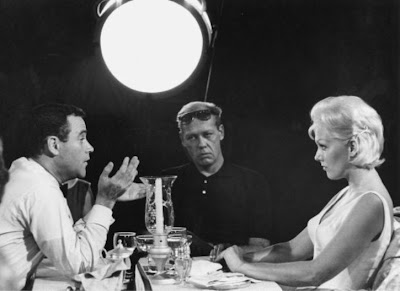
Richard Quine directs Jack Lemmon & Kim Novak in "The Notorious Landlady" (Columbia, 1962)
"I'm a Democrat from New England - I have no prejudices"
-Jack Lemmon as the young diplomat William Gridley
in "The Notorious Landlady"
-Script by Blake Edwards and Larry Gelbart
-Directed by Richard Quine
On today's Star of the Month tribute to Jack Lemmon, the Turner programmers have craftily gathered a bunch of titles directed by the talented but woefully neglected (and ill-fated) Richard Quine.
Before there was the team of Wilder and Lemmon, there was Quine and Lemmon - who worked on a series of collaborations that I find more appealing and companionable than the films that Jack made with Billy. (I know, I know: Blasphemy!) The two pairings overlapped for a short time: Jack worked regularly with Quine early in his career (six films), while he spent a good part of the middle section working for Wilder (seven titles). (Quine died at age 69 in 1989 from a self-inflicted gunshot wound; Wilder died of pneumonia in 2002 at age 96, outliving Lemmon by two years.)

Jack's work with Quine is pretty even-keeled, all of their films solidly good, whereas his work with Wilder is all over the map, ranging from classic to, well, unwatchable ("Buddy, Buddy," anyone? "The Front Page"?).
Quine and Lemmon both came to Columbia at the same time, with Quine directing the actor's screen test there. They collaborated in 1954 on "Extra Dollars," a promotional piece made for the United States Treasury Department before making their first movie together, 1955's "My Sister Eileen," aired on 8 January as part of the tribute.
Their five remaining titles are on tonight, plus Jack's two collaborations with David Swift, the puerile "Under the Yum Yum Tree" and the charming "Good Neighbor Sam" - with Turner honoring their chronology.
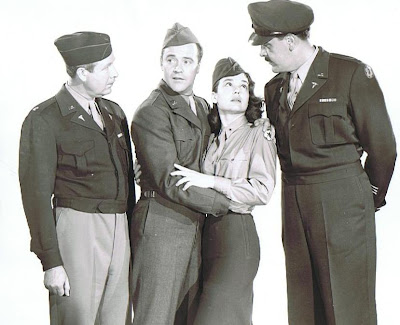
The cut-ups in Quine's "Operation Mad Ball" - Arthur O'Connell, Jack, Kathryn Grant and Ernies Kovacs"Operation Mad Ball" (1957) - Wednesday, 21 January at 8 p.m., est. Lemmon and Matthau? How about Lemmon and Kovacs? Jack originally teamed with the singular comic Ernie Kovacs in three films, starting with this antic military farce, something of a precursor to Robert Altman's equally anarchic "M*A*S*H." Kovacs is shamelessly funny (as his Mickey Rooney in a small role as a cut-up eccentrically named Yancy Skibo), and one can only imagine what the late comeic might have been like opposite Lemmon in "The Odd Couple." OK, they were the original Odd Couple. (With sincere apologies to Walter Matthau.) The ace supporting cast as the GIs: Dick York, Roger Smith, William Hickey, William Leslie, L.Q.Jones, Dick Crockett, Paul Picerni, Eddie Ryder and David McMahon.
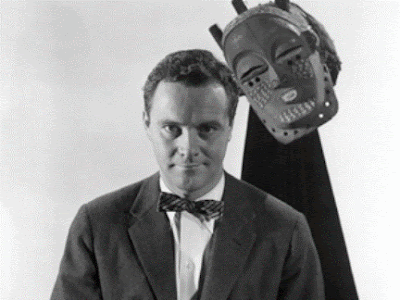
Jack as the playful warlock in Quine's "Bell, Book and Candle" (1958)"Bell, Book and Candle" (1959), airing 10 p.m., est. A film that refuses to age. It's forever modern, with Kim Novak (Quine's muse) as a witch who casts a spell on Jimmy Stewart so that love is unavoidable. Jack, Hermione Gingold and Elsa Lanchester are assorted witches causing mayhem on the periphery; Ernie Kovacs is the quack writer hoping to expose/exploit them. Pay attention to James Wong Howe's shimmering photography and George Duning's memorable score.
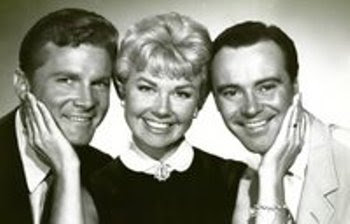
Doris caught between Jack and Steve Forrest in Quine's "It Happened to Jane" (1959)"It Happened to Jane" (1959), airing at 11:45 p.m., est. This one has been called Capra-esque, but it's actually better than Capra. Aside from Ernie Kovacs' wicked impersonation of Columbia head Harry Cohn (who, conveniently, died a year before production), this Lemmon-Quine film boasts two sequences that are better than anything in Lemmon-Wilder collaborations - the town meeting, filmed verité style by Quine using the real townspeople of Chester, Conn. (where the film was made), and the sly scene in which Doris Day finesses a declaration of love out of Jack's character, staged while Jack shovels coal into a train's engine.

Jack taking a leap of faith in Quine's "The Notorious Landlady" (1962)"The Notorious Landlady" (1962), airing Thursday, 22 January at 1:30 p.m., est. This velvety take on Hitchcock - part comedy, part mystery - was adatped from a short story bby Margery Sharp by the estimable Blake Edwards and Larry Gelbart. Quine directed, natch, and a great cast came through for him - Jack, Kim, Fred (Ataire), Lionel Jeffries, Estelle Winwood, Philippa Beavans and Maxwell Reed. This is the one Lemmon film that I can't get enough of (pardon the dangling participle).
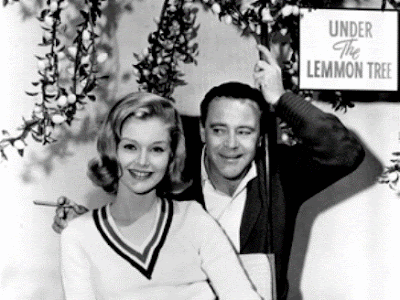
Jack lusting after Carol Lynley in Swift's "Under the Yum Yum Tree" (1963)"Under the Yun Yum Tree" (1963), airing at 3:45 a.m., est. This is pure junk. Jack inherited his role as a womanizing landlord who rents only to ... women from Gig Young, who played the role on stage. It remains Jack's biggest money maker - and given that it followed another puerile hit, "Irma La Douce," it made him the biggest box-office draw of that year. Much to Jack's mixed feelings of delight and chargin.

Jack painting himself into a corner in Swift's "Good Neighbor Sam" (1964)"Good Neighbor Sam" (1964), airing at 5:45 a.m., est. I love this comedy. It has the contours of a classic farce, but its crtedibility was hurt because Jack and David Swift had collaborated just a few months earlier on the highly disposable (albeit entertaining) "Under the Yum Yum Tree." Jack steps into a vintage Cary Grant role here (read: "Bringing Up Baby," replete with eyeglasses). Composer Frank deVol wrote a delightful theme for the film, and co-star Romy Schneider, in her second American film (following Otto Preminger's "The Cardinal" in 1963), is clearly having the time of her life. Bonuses: pert Dorothy Provine as Mrs. Sam; Frank DeVol's happy score and the soothing, pastel-tinted photography of master cinematographer Burnett Guffey ("Bonnie and Clyde").

Jack scaling heights in Quine's "How to Murder Your Wife" (1965)"How to Murder Your Wife" (1965), airing at 8 a.m., est. Jack' final film with Quine has a huge fan base, but, frankly, its appeal has always been lost on me. The film - a sexist romp - want to have it both ways, lampooning sexism while also embracing it. Jack plays a well-fed, pampered creator of a hugely popular comic strip, "Brash Bannigan," whose antics he acts out. Nice touch. But when he attends a bachelor party and, drunkenly, ends up married himself (to that dish, Virna Lisi), he incorporates it into his strip, ruining it. The only way out? Murder his wife, of course. While Jack and Virna have no visible chemistry, our guy makes out like gangbusters with Terry-Thomas, Eddie Mayehoff, Clair Trevor and Max Showalter. The movie has its moments, but this is one case where location photography (New York) was a hindrance. This cartoonish material begs out for the artificial feel of a soundstage.
No comments:
Post a Comment